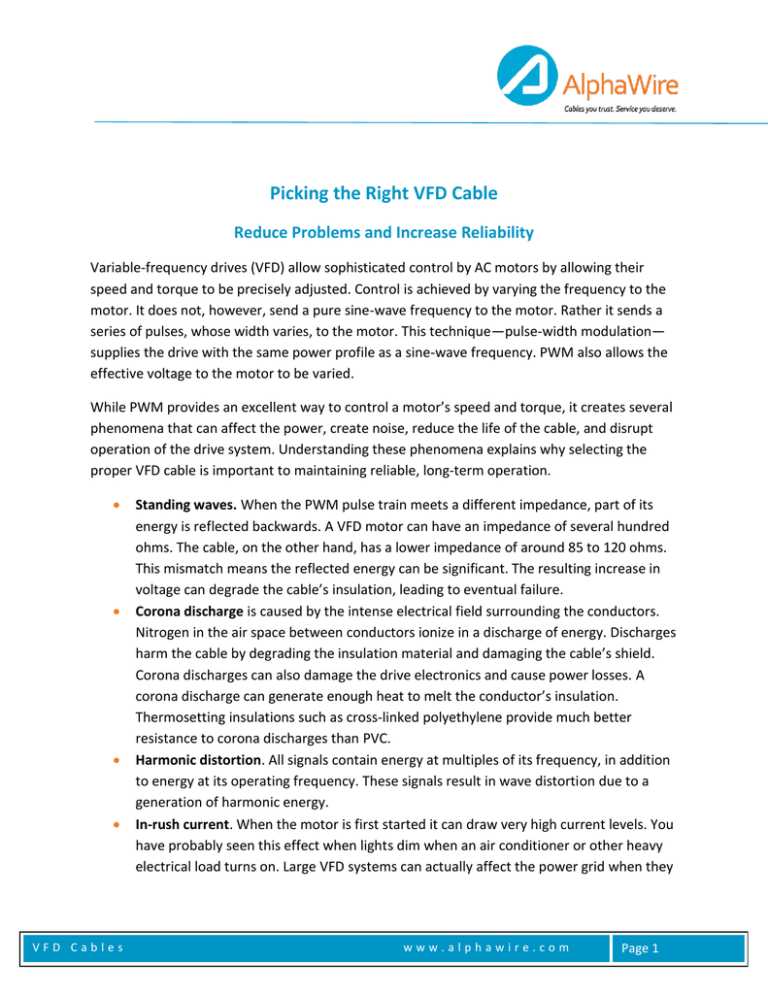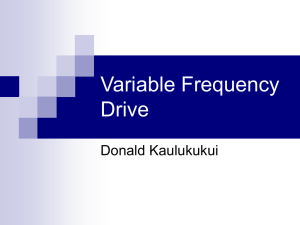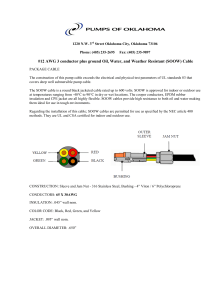
Picking the Right VFD Cable
Reduce Problems and Increase Reliability
Variable-frequency drives (VFD) allow sophisticated control by AC motors by allowing their
speed and torque to be precisely adjusted. Control is achieved by varying the frequency to the
motor. It does not, however, send a pure sine-wave frequency to the motor. Rather it sends a
series of pulses, whose width varies, to the motor. This technique—pulse-width modulation—
supplies the drive with the same power profile as a sine-wave frequency. PWM also allows the
effective voltage to the motor to be varied.
While PWM provides an excellent way to control a motor’s speed and torque, it creates several
phenomena that can affect the power, create noise, reduce the life of the cable, and disrupt
operation of the drive system. Understanding these phenomena explains why selecting the
proper VFD cable is important to maintaining reliable, long-term operation.
VFD Cables
Standing waves. When the PWM pulse train meets a different impedance, part of its
energy is reflected backwards. A VFD motor can have an impedance of several hundred
ohms. The cable, on the other hand, has a lower impedance of around 85 to 120 ohms.
This mismatch means the reflected energy can be significant. The resulting increase in
voltage can degrade the cable’s insulation, leading to eventual failure.
Corona discharge is caused by the intense electrical field surrounding the conductors.
Nitrogen in the air space between conductors ionize in a discharge of energy. Discharges
harm the cable by degrading the insulation material and damaging the cable’s shield.
Corona discharges can also damage the drive electronics and cause power losses. A
corona discharge can generate enough heat to melt the conductor’s insulation.
Thermosetting insulations such as cross-linked polyethylene provide much better
resistance to corona discharges than PVC.
Harmonic distortion. All signals contain energy at multiples of its frequency, in addition
to energy at its operating frequency. These signals result in wave distortion due to a
generation of harmonic energy.
In-rush current. When the motor is first started it can draw very high current levels. You
have probably seen this effect when lights dim when an air conditioner or other heavy
electrical load turns on. Large VFD systems can actually affect the power grid when they
www.alphawire.com
Page 1
turn on. While it is normal practice to ramp up motor speed slowly to minimize in-rush
current, it can still occur.
EMI. A natural byproduct of a digital system is the creation of energy that radiates as
electromagnetic interference. This energy can transfer to other circuits, causing signal
degradation, false signals, and other problems.
Designers of VFD drives and motors go to great lengths to control and minimize the effects
discussed above. Although they cannot be completely eliminated, their effects can be reduced
by selecting components specifically designed for VFD systems.
VFD Cables
Figure 1. VFD cable
Cable used to connect the VFD drive to the motor affect how well the VFD system handles the
phenomena with potential to disrupt operations. Cables designed specifically for VFD
applications (see Figure 1) withstand these phenomena. And, equally important, they do
nothing to make the situation worse. A generic motor supply cable is not designed with the
specific requirements of VFD system in mind actually cause problems.
Here are some of the things to look for in a VFD cable.
Insulation
The insulation must have excellent dielectric properties to prevent breakdown from the
stresses of voltage and current spike, corona discharges, and so forth. Cross-linked
polyethylene (XLPE) has the required properties, making it a better choice than standard
polyethylene or PVC. XLPE insulation helps reduce the potential effects of harmonics and
VFD Cables
www.alphawire.com
Page 2
corona discharge, therefore providing stable electrical performance which prolongs the life of
the cable. This reduces the need for costly downtime due to cable failure.
Shielding
Shielding serves the double purpose of keeping noise generate by the VFD cable from escaping
and preventing noise generated outside the system from being picked up. There are three types
of shields typically used:
Foil shielding uses a thin layer of aluminum, typically laminated to a substrate such as polyester
to add strength and ruggedness. It provides 100% coverage of the conductors it surrounds,
which is good. It is thin, which helps keep cable diameters small, but is it harder to work with,
especially when applying a connector.
A woven braid provides a low-resistance path to ground and is much easier to termination by
crimping or soldering when attaching a connector. Depending on the tightness of the weave,
braids typically provide between 70% and 95% coverage. Because copper has higher
conductivity than aluminum and the braid has more bulk for conducting noise, the braid is
more effective as a shield. But it adds size and cost to the cable.
A third approach combines both foil and braid shields in protecting the cable. Each supports the
other, overcoming the limitations of one with its own compensating strengths. As shown in
Figure 2, this presents shielding effectiveness superior to either approach alone.
One purpose of the shield is to provide a low-impedance path to ground. Any noise on the
shield thus passes to ground. A poor ground connection can increase the impedance, which also
increases the potential for noise to be coupled to nearby cables or equipment.
Figure 2. Foil-braid shielding yields the best shielding effectiveness
VFD Cables
www.alphawire.com
Page 3
Cable Geometry
A round, symmetrical cable gives the best electrical performance and resistance to deleterious
effects. One reason is that round symmetry creates more uniform electrical characteristics in
the cable. The electrical characteristic of one conductor doesn’t differ significantly from
another. For example, having the ground wires places symmetrically around the cable provides
a more balanced grounding system.
The Right Cable Prevents Problems
The cable selected for interconnecting a variable-frequency drive to a motor can significantly
influence the reliability of the system. The wrong cable can increase problems and lead to
premature failure. The right cable, on the other hand, can actually reduce the potential from
problems like corona discharge or standing waves. Alpha Wire offers a broad line of cables
specifically designed to allow a VFD system to operate flawlessly to its fullest potential.
Alpha Wire Series V VFD Cables at a Glance
3- and 4-conductor cable
16 to 4/0 AWG
14-AWG brake pair
XLPE insulation
PVC jacket
Small diameter
Low capacitance for improved signal
transmission
UL TC‐ER, 90°C, 600 Volts
UL Direct Burial
UL Sunlight Resistant
UL 1000 Volt Flexible Motor Supply
Cable rating
GLOBAL HEADQUARTERS
711 Lidgerwood Avenue
Elizabeth, NJ 07207-0711 USA
Toll Free: 1-800-52 ALPHA
Tel: 1-908-925-8000
Fax: 1-908-925-5411
E-mail: info@alphawire.com
©2009 Alpha Wire. All rights reserved.
VFD Cables
CSA AWM I/II A/B FT4, 90°C , 1000 Volt
rating
CE approved
Meets RoHS & California Proposition 65
requirements
Suitable for use in 2008 NEC Class I & II,
Division 2 locations
MSHA Approved
Pennsylvania MSHA Approved
High-conductor-strand count for good
routing flexibility and vibration resistance
EUROPE
Alpha Wire International
Sunbury Int’l Business Centre, Brooklands Close
Windmill Road, Sunbury-on-Thames, Middlesex
United Kingdom TW16 7DX
Tel: +44 (0) 800 288 8809
Fax: +44 (0) 800 288 8810
E-mail: europe@alphawire.com
Lit. No: VFDMRO-WP-0901
Supersedes: New
www.alphawire.com
Page 4




